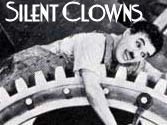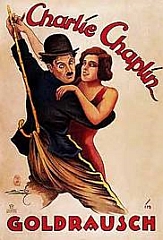THE GOLD RUSH
Original version released 1925Chaplin's re-edited rerelease with narration, 1942
With Charlie Chaplin, Mack Swain, Tom Murray, Henry Bergman, Malcolm Waite, Georgia Hale
Written and Directed by Charles Chaplin
Silent, Black and White
Reviewed by JB
This review is based on both versions of the film.
 The
film for which Chaplin wanted to be
remembered, THE GOLD RUSH, in which The Little Tramp suffers hardship
and heartache while searching for gold in the Yukon, is much revered by
film buffs and has often been called Chaplin's
greatest movie. It features two of the comedian's most
fondly
recalled routines, "The Shoe Dinner" and "The
Dance of the Rolls". Despite all this, THE
GOLD RUSH has always been my least favorite silent Chaplin feature.
The
film for which Chaplin wanted to be
remembered, THE GOLD RUSH, in which The Little Tramp suffers hardship
and heartache while searching for gold in the Yukon, is much revered by
film buffs and has often been called Chaplin's
greatest movie. It features two of the comedian's most
fondly
recalled routines, "The Shoe Dinner" and "The
Dance of the Rolls". Despite all this, THE
GOLD RUSH has always been my least favorite silent Chaplin feature.
I think it was because when I was younger and used to read about Chaplin and silent movies before actually having a chance to see many of them, it was drummed into me that "The Shoe Dinner" in which a starving Chaplin treats a boiled shoe as if were a sumptuous feast, and "The Dance of the Rolls" where Chaplin uses forks stuck in two dinner rolls as a pair of dancing feet, were the be-all and end-all of silent comedy, masterpieces that could not be topped. When I finally got around to seeing THE GOLD RUSH - well, as two bits of revered pantomime go, the two scenes are nice, but neither of them impressed me all that much and my opinion of the film suffered for it.
Anyway, I am over all that now. THE GOLD RUSH may still not be my favorite Chaplin feature, but I have come to like it much more than I used to. There is a love story at the heart of the film, a one-sided love story as Charlie the prospecter falls hard for a dance hall girl named Georgia (Georgia Hale). I have always been a sucker for Chaplin's facial expressions, and still marvel at how much he can express with just the subtlest movements of his eyes and mouth. For instance, there is a great scene in which, having been told by the departing Georgia that she will be back on New Year's Eve to have dinnner with him, the Little Tramp does a dance of joy in his little cabin, tearing up his pillow and sending feathers flying all over the place. Of course, this is the moment Georgia comes back to retrieve the gloves she forgot. The tramp doesn't bother to explain why there are feathers everywhere, including on his clothes and in his hair, he just politely inquires what she wants, retrieves the gloves and sends her on her way. After which, he stands with a blank look on his face for several seconds, and yet we can read every thought in his mind, and there are dozens of them.
The New Year's Eve scene itself, in which Charlie realizes Georgia never had any intention of showing up at his cabin, features more of Chaplin's acting at its best. At midnight, as revelers at the nearby dance hall begin singing "Auld Lange Syne", the tramp stares out his cabin door with sunken eyes. He knows Georgia is there, having the time of her life, while he is alone, in his cabin with all his decorations and party favors gone to waste. So he stares, and there's just the tiniest hint of him trying to stifle his emotions. And it breaks my heart. Kids, don't try this at home. Only the true masters could mingle comedy with tragedy successfully, and Chaplin was the king (and even he couldn't always pull it off successfully). In the original silent version, Chaplin the director ups the emotional ante by showing us closeups of several of the New Year's partiers themselves, thinking about their own pasts, their present and their futures as the new year is rung in, and clearly not liking what they see.
Many of the effects in THE
GOLD RUSH are
utterly unconvincing, such as the models used to represent a
cabin
teetering on the edge of a mountain. Yet "inside" the cabin,
Chaplin and his prospecting partner, played by the huge and funny Mack
Swain, are so expert at convincing us that they are indeed in
mortal
danger, the scene is still funny in spite of itself. (Buster
Keaton would have used a real cabin, a real mountain and risked his
life twenty times
over in a scene like this). The timing of Charlie
and Mack's
movements inside the cabin are perfectly and hilariously choreographed. Of course, that
choreography probably took something like 273 takes before Chaplin was
happy with the scene, but that is what makes the best of Charlie
Chaplin so good.
In 1942, on the heels of his success in his first full talkie THE GREAT DICTATOR,
Chaplin rereleased THE GOLD RUSH, removing several scenes, re-editing some sequences and replacing
all intertitles with his own narration. This is the version I am
most used to, and I've always been on the fence about it. Chaplin
certainly put much care and effort into the narrated version, and
despite a bit too much talking from the master, THE GOLD RUSH reissue
is still a fine film. Still, considering Chaplin is the man who kept
the
spirit of silent movies alive well into the 1930s with CITY LIGHTS and
MODERN TIMES,
I think he should have had more faith in his
own art and in the viewing public and perhaps just rereleased the
silent version with a newly composed musical soundtrack. It is
the original silent GOLD RUSH that
remains the preferable version to watch.  - JB
- JB


